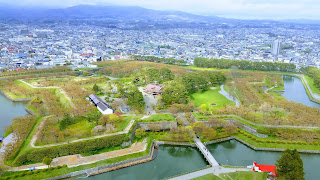History of Goryokaku Fort
This all started in 1853 when Matthew Perry arrived and demanded that Japan open it's doors to trade with the rest of the world. A year later, in 1854, the Tokugawa shogunate concluded the Treaty of
Peace and Amity between the United States of America and Empire of Japan and Hakodate and Ezo were designated as open ports.
When the ports were opened, they created the magistrate's office to govern Ezo and the Hakodate port.
Once the port was opened, sailors and men from overseas came to Hakodate almost every day to buy and sell goods.
The Hakodate Magistrate promoted industrial development while trying to increase the defensive capabilities of the area. A man named Takeda Ayasaburo, a researcher of Dutch studies, expanded the plan for the new fort, which he modeled after European citadel towns. Goryokaku fort is shaped like a five-pointed star. This allowed for a greater numbers of gun emplacements on its walls than a traditional Japanese fortress, and reduced the number of blind spots where a cannon could not fire.
Young people aspiring to have academic careers gathered from all over Japan to learn from Ayasaburo Takeda, who served as a professor. He devoted himself to teaching Dutch, navigation, surveying, shipbuilding, chemistry and other technical skills and knowledge and helped educate and develop the leaders of modern Japan.
Construction of Fort Goryokaku began in 1857. After seven years of construction, Fort Goryokaku was essentially completed in 1864.
On October 20, 1868, deserters from the former shogunate’s army landed on the coast of Washinoki, 45 km north of Hakodate, and the troops headed towards Fort Goryokaku in Hakodate.
Even though the new Hakodate government in Fort Goryokaku sent troops to attack the deserters approaching Hakodate, the deserters were more experienced in battle and the deserters, led by Takeaki Enomoto, entered Fort Goryokaku.
The deserters who occupied Hakodate proposed peaceful coexistence with the Matsumae clan, but the Matsumae refused this proposal, so the deserters sent their army to occupy Matsumae. Tate Castle, which was the Matsumae clan’s fort, was attacked by the deserters and captured despite the resistance of Chojun Mikami, a Buddhist priest and the leader of the Matsumae troops.
The battleships Kaiyo, departed to support the attack on Matsumae from the sea, but were destroyed in Esashi Port due to a winter storm.(Toshizo Hijikata, who led the army to Esashi, stood in stunned silence as he watching the Kaiyo being smashed by the rough waves.)
Deserters from the former shogunate’s army defeated the Matsumae clan and occupied the entire territory of Ezo even though they lost the battleship Kaiyo. They celebrated the victory on December 15, 1868, by firing their cannons 101 times at the Hakodate Port. They established a provisional government under the presidency of Takeaki Enomoto.
A few months later, in March 1869, a battalion of the new Meiji Government Army landed on the coast of Otobe along the Sea of Japan. They began to fight back against the deserters. They divided their army into three squads and began to advance toward Fort Goryokaku in Hakodate.
Toshizo Hijikata’s troop, the leader of the deserters, established a position along the Esashi mountain path to confront the battalion from the new government. They drove it back after a fierce gun battle, but the new government’s army, advanced further toward Fort Goryokaku by adding the second and third reinforcements.
The new government’s army surrounded Hakodate and Fort Goryokaku and finally began an all-out attack on May 11, 1869. The town of Hakodate was occupied by a team that climbed up the back of Mt. Hakodate. Although Toshizo Hijikata tried to recapture Hakodate after hearing about the occupation, he was shot and killed in a battle.
A group of troops from the government’s army stormed into Hakodate Hospital, which had been established by the deserters. Ryoun Takamatsu, the director of the hospital, described the importance of the spirit of the Red Cross to save the lives of the sick and injured. Then new government’s army promised not to harm the patients and had Takamatsu persuade the deserters to surrender after that.
Takeaki Enomoto and other leaders of the deserters announced their surrender before the Kameda Hachimangu shrine on May 17, 1869. On the next day, they handed Fort Goryokaku over to the new government’s army and the Hakodate War ended. This was the end of the Restoration period and the beginning of the Meiji era.
After the end of Hakodate War, natural ice was
collected from the moat of Fort Goryokaku in winter. It evolved into a major
industry and it was sold in Honshu under the name of “Goryokaku Ice”.
Today, Fort Goryokaku, is a park. It became a park in 1914 and was designated as a special historic site in 1952. It is also home to the Hakodate city museum, and the grounds are a favorite spot for cherry-blossom viewing in the spring. Goryokaku Tower was first opened in the park on December 1, 1964 and still offers an amazing view of the star fort.




















Last time, I enjoyed the washington cherry blossom. Now I plan to explore This park and enjoy the best time there.
ReplyDelete